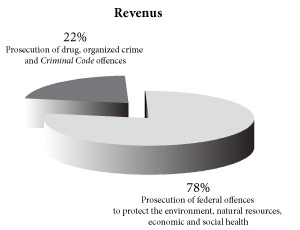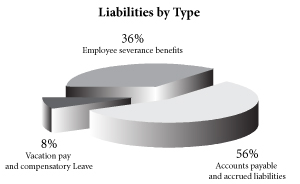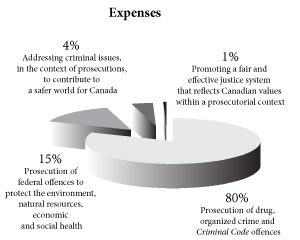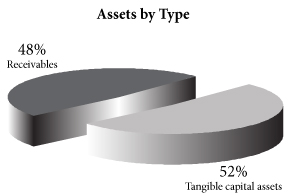Common menu bar links
Breadcrumb Trail
ARCHIVED - Public Prosecution Service of Canada
 This page has been archived.
This page has been archived.
Archived Content
Information identified as archived on the Web is for reference, research or recordkeeping purposes. It has not been altered or updated after the date of archiving. Web pages that are archived on the Web are not subject to the Government of Canada Web Standards. As per the Communications Policy of the Government of Canada, you can request alternate formats on the "Contact Us" page.
SECTION III: SUPPLEMENTARY INFORMATION
3.1 Financial Highlights
The financial highlights presented within this DPR are intended to serve as a general overview of the PPSC’s financial position and operations. The PPSC’s financial statements can be found on its website at : http://www.ppsc-sppc.gc.ca/eng/pub/index.html
| Condensed Statement of Financial Position At End of Year (March 31, 2009) |
% Change | 2009 | 2008 |
|---|---|---|---|
| Total Assets | 15 % | 11,420 | 9,908 |
| Total Liabilities | 31% | 38,552 | 29,427 |
| Total Equity | -39% | -27,132 | -19,519 |
| Total | 15% | 11,420 | 9,908 |
| Condensed Statement of Financial Position At End of Year (March 31, 2009) |
% Change | 2009 | 2008 |
|---|---|---|---|
| Total Expenses | 19% | 155,771 | 130,745 |
| Total Revenues | 4% | 12,529 | 12,010 |
| Net Cost of Operations | 21% | 143,242 | 118,735 |
|
Total assets were $11.4 million at the end of 2008-09, an increase of $1.5 million over the previous year’s assets of $9.9 million. Receivables and tangible capital assets represented the bulk of the PPSC’s assets. |
 |
Total revenues did not increase significantly from 2007-08. The majority of revenues (78%) stemmed from the recovery of costs from federal investigative agencies for the prosecution of federal offences to protect the environment, natural resources, as well as economic and social health. The remaining 22% consisted of costs recovered in relation to drug, organized crime and Criminal Code prosecutions as well as the recovery of outstanding federal fines. |
 |
Total liabilities were $38.6 million at the end of 2008-09, an increase of $9.1 million over the previous year’s liabilities of $29.4 million. Accounts payable, accrued liabilities and employee severance benefits represented most of the PPSC’s liabilities. Although all three types of liabilities increased from the previous year, the greatest increase was related to larger accounts payable and accrued liabilities which increased by $7.3 million or 51%. |
 |
Total expenses for the PPSC were $155.8 million in 2008-09, which increased by 19% over the previous year. The majority of funds, $126.4 million or 81%, were spent in the prosecution of drug, organized crime and Criminal Code offences due to increased agent fee rates. The expenses in this area increased by 24% over 2007-08. |
3.2 List of Tables
The following tables are located on the Treasury Board Secretariat website:
http://www.tbs-sct.gc.ca/dpr-rmr/st-ts-eng.asp
Horizontal Initiatives (National Anti-Drug Strategy, lead by the Department of Justice Canada)
Sources of Respendable and Non-Respendable Revenue
3.3 Other Items of Interest
Public Prosecution Service of Canada Annual Report 2008-2009
http://www.ppsc-sppc.gc.ca/eng/pub/index.html
The Federal Prosecution Service Deskbook
http://www.ppsc-sppc.gc.ca/eng/pub/fpsd-sfpg.html
PPSC Survey of Investigative Agencies
http://www.ppsc-sppc.gc.ca/eng/pub/index.html
1The PPSC was created on December 12, 2006, when the Director of Public Prosecutions Act, Part 3 of the Federal Accountability Act, came into force. The Public Prosecution Service of Canada is the Office of the Director of Public Prosecutions’ applied title.
2This comprises cases opened, as well as those carried over from the previous fiscal year, both for staff counsel and private-sector legal agents.
3The difference of $16.4 million between total authorities and planned spending in 2008-09 was due to an increase in funding received for the prosecution of drug offences and to provide greater support for Crown agents across Canada. Actual spending was $32.6 million lower than the total authorities due to $20 million in frozen allotments which were not released as the conditions established by the Treasury Board were not fulfilled (e.g., the passage of specific legislation) and to $12.6 million in unspent funds.
4Agent fee rates were increased for the first time in over 18 years, following approval from the Treasury Board of Canada. The new rates came into effect in April 2008 and will increase in future years in alignment with the Consumer Price Index.
5The operational priority for prosecution-related advice provided during investigations is primarily focussed on highly complex and mega cases and cases involving a high degree of legal risk.
6In Budget 2007, the Government, while recognizing the value of the Integrated Market Enforcement Teams (IMETs) in investigating complex capital markets crime acknowledged that the results achieved to date suggested that there is room for improvement. A senior expert advisor, Mr. Nick Le Pan (former Federal Superintendent of Financial Institutions) was appointed to advise the RCMP and federal partner departments, and to help develop and guide the implementation of a plan to improve the effectiveness of IMETs. Mr. Le Pan’s report was submitted to the RCMP Commissioner in October 2007 and is available at:http://www.rcmp-grc.gc.ca/imet-eipmf/pdf/report-rapport-lepan2007-eng.pdf.

